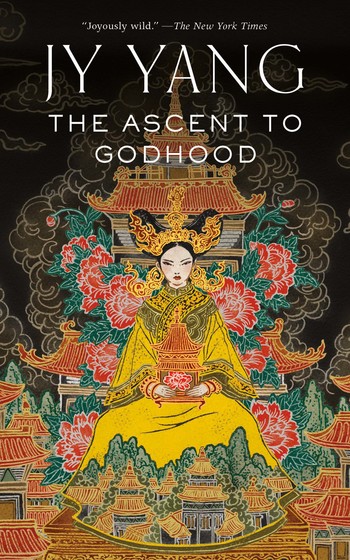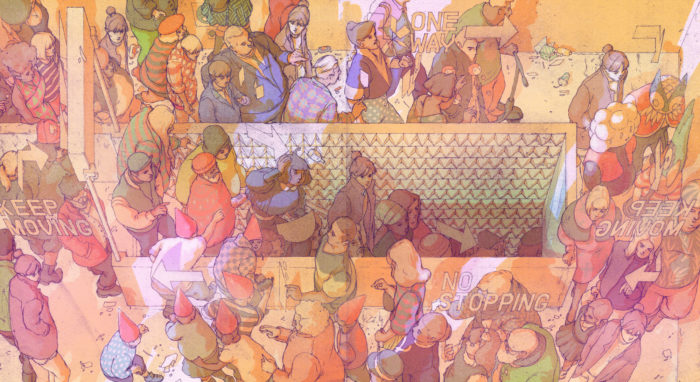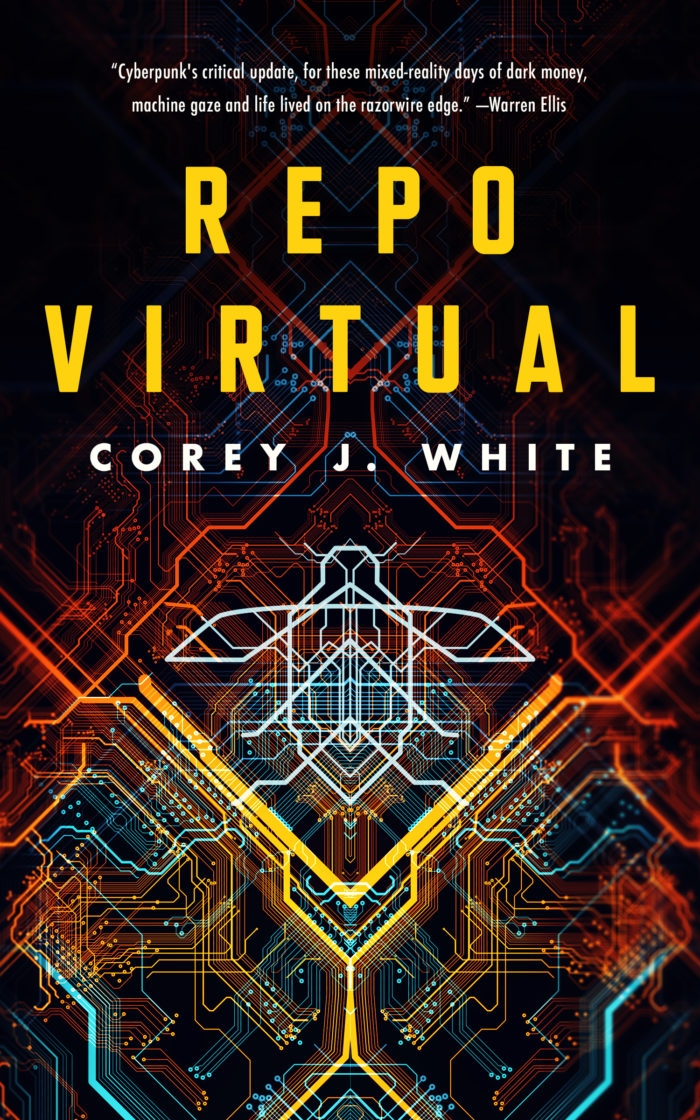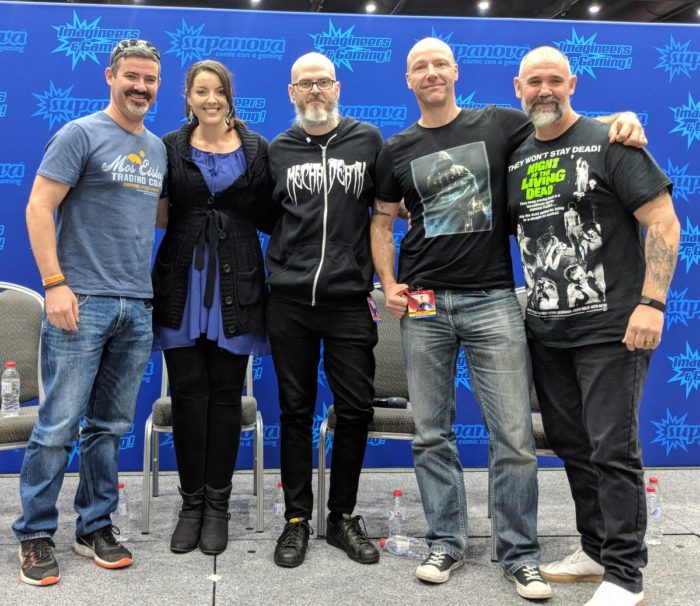The first thing you might notice about this post is that I specifically called it “Character Sheets” and not “Characters” or “Characterisation”. Here we’re still talking about the outlining/planning phase of a novel, following on from the last Process post. I’m going to explain my process for fleshing out a character, but obviously these characters will grow, change, and evolve throughout the process of writing the book. One day I’ll probably try and talk about that process, but it’s much more organic/instinctual than this first stage, so we’ll just have to wait and see. (If nothing else, I could certainly provide examples of how some of my characters were utterly changed in the process of writing a book – for instance, there are 2 big examples of this in Repo Virtual.)
To start with, I will just say that I first put these character sheets together after trawling through Chuck Wendig’s blog for writing advice. I would link to the individual posts in question, except this was approximately 4 years ago (in the lead-up to writing Killing Gravity, actually), so I’ve lost the specific links. But, just to be clear – this is me distilling some advice that came from Chuck Wendig. If you ever need more writing advice than the (admittedly rare) advice I give here, Chuck’s blog should be your first port of call. Also, because I pieced my character sheet together from 2 or 3 of Chuck’s blog posts, it might seem like some sections overlap and/or are redundant. Strictly speaking, that’s true, but I find the overlapping can help. It might help you realise that the character is particularly one-minded, or it might help you realise that the character has multiple different fears/goals/whatevers going on at once. The redundancies are deliberate, and occasionally useful. (But, as ever with writing advice, YMMV. Feel free to alter the character sheet to suit your own style/needs).
As I said up top, we’re still in the planning phases of the novel when we begin putting these character sheets together. At this point you should know how many characters are in your story, and have a vague idea of what they need to do/how they need to interact with your main character. This early on, it could be easy to see them as puzzle pieces (with the plot/story being the puzzle you’re trying to solve), so with the character sheets we’re trying to learn more about these characters, flesh them out, and let them become real people (for whatever value of “real” you want/are able to apply to them).
Character Sheet
The character sheet is basically just a list of questions that will help you to think about who these people both in relation to the story you’re trying to tell and external to it. Some of your answers will prove important and enlightening, and will almost certainly end up becoming focal in your story, other answers will never make it onto the page, but will help you to think about these characters as real people.
Let’s begin.
0. Initial Log-Line
I call this one number 0, because I don’t always use it. The idea here is to write a very brief log-line for the character. Think of this as the back cover blurb or film trailer narration of this character’s story. This is always going to be easiest/most obvious for your protagonist/s. For this reason I recommend starting with your biggest characters and making your way down. (You’ll probably want to do a character sheet for every main and secondary character. You can skip the tertiary characters though – the ones who only appear in a scene and don’t have an arc.)
Example from Repo Virtual: JD hustles with the best of them, taking any work he can to help support his mother. Working as a repo man, JD repossesses rare loot in the game worlds and expensive belongings in the real. But when he takes a job that’s too good to be true, he finds himself in possession of the world’s first true strong AI… and a target for corporate and terrorist groups that seek to use the AI for their own ends.
1. What do they want?
2. What do they need?
(Yes, I’m going to use singular they. Deal with it. If you’re at this blog you should already know I’m all about the singular they.)
I’m pairing these two together, because they can interact with each other in interesting ways. Sometimes what the character wants will parallel with what they need, other times the two will stand at opposition. Sometimes it will be what the character wants that drives them through the story, and not what they need, other times vice versa.
For example, maybe your character wants to achieve world domination, so what they need to do is distract the other characters long enough for their plan to come to fruition. World domination is the bigger desire, but I wouldn’t call it a need.
Another character might need to find a cure for the nanomachine virus that’s slowly tearing apart their mother’s body, but all they want is to be able to stop, relax, and drink a cup of tea. The cure is the need that will drive them forward, but the desire for rest could throw an interesting monkey wrench into the works.
3. What do they fear?
This doesn’t have to be the character’s “greatest fear”, or something obvious like heights, spiders, or clowns. It can be that, but it doesn’t have to be. For instance, I don’t necessarily have one of those big fears, but I sure as hell have a bunch of weird, subtle fears and other psychological quirks.
So someone might fear leaving or losing their children. This seems obvious. But someone else might fear disappointing their children if they return home without enough food/money/whatever, and so they’ll stay away from their children for longer.
Someone might fear going bald. Someone might fear their boss. Someone might fear fucking up – someone might fear fucking up so badly that they never try in the first place and are thus a complete fuck up.
What I’m trying to say here is: think beyond the obvious phobias and use this as an opportunity to delve into the psychology of your characters.
4. Win/Lose/Draw
Simply: what are the win, lose, and draw conditions for this character?
This is one of those sections that can seem redundant. If you already know what the characters wants and needs, then you already have a good idea of what their Win and Lose look like. So, if you’re talking about your main protagonist, the most interesting part will probably be the Draw – what concessions are they willing to make if they can’t Win, but refuse to Lose? Or, if you’re talking about side characters or villains, the Lose condition might be their fate if they’re standing in the way of your hero. Consider this brainstorming for how your characters might end up at the closing of your story.
5. Goals & Barriers
What are the character’s goals, and what barriers stand in their way?
Again, the goals part of this can seem obvious – it’s going to be their Win condition, and it’s probably going to be their need or want. Where it gets interesting is when you start to consider the barriers that stand in their way. This could be mundane, or as weird as you want to make it. You’ll probably get the most bang for your buck if the barrier to one character’s goal is something a different character does to achieve their goal. Tension between characters is conflict, and conflict is what fuels great storytelling.
6. What choices must they make?
This one can be really interesting. Every character in your story needs to make decisions – whether that’s the initial decision that gets them wrapped up in the happenings of the story, or a bad decision that puts everyone in danger, or a tough decision at the end of the story to sacrifice something in order to save something bigger. Depending on the character they might have difficult decisions to make the whole way through the plot, or for a smaller character they might only get one. Either way though, if a character isn’t making a decision, then they’re probably being dragged along by the plot, which can feel really unsatisfying to a reader.
7. Character’s Problem
8. Character’s Solution
This is the bit where I’m going to start paraphrasing Chuck, because he already distilled these ideas down really well, and I found them super useful.
The Character’s Problem is why they find themselves in the story. For example, John McClane’s problem isn’t the terrorists, it’s his failing marriage. Without that failing marriage, he wouldn’t be in LA trying to patch things up with his wife, and he wouldn’t get caught up in the whole situation. The terrorists aren’t a character’s problem, they’re a plot problem.
The Character’s Solution is not your solution. It’s how the character thinks they’re going to solve their problem. Hint: The character can be wrong about their solution. In the gap between the Problem and the Solution is where the conflict lives. And what did I say about conflict before?
9. Limitations
10. Complications
More pure, uncut Chuck. Limitations are internal to the character – a character trait or personal flaw that might help or hinder them (whether or not this trait appears to be positive). Complications are external.
I was going to try and keep rehashing, but instead I spent a couple of minutes looking through the Terrible Minds archive, and found the post. (This is definitely one of the two or three posts I originally used, so you’ll likely find value in reading through it.)
To quote:
A limitation is generally internal — meaning, it’s something within the character that exists as part of their nature. This limitation hobbles them in some way, altering their problem/solution dichotomy (which we could ostensibly call “the mission”).
Remember how I was talking about Dexter’s “code of honor?” I consider this a limitation to his character — we the audience would perceive that as a strength but to Dexter, it’s also a limitation. It puts a limit on his role as a serial killer and thus creates not only a deeper character, but also offers new plot angles and opportunities for tension.
Limitations are traits of the character’s that get in her way — they might be flaws or frailties but they can just as easily be positive traits that make trouble for the character and the plot.
Complications tend to be external — they are entanglements outside the character that complicate their lives. These can be more character-based or more plot-based depending on which aspect of the story you’re working. John McClane’s job is a character complication — he’s married more to the job than he is to his wife, which is what leads to the problem, which demands a solution, which opens the door for conflict. And the conflict is further complicated by his intensely cop-flavored demeanor, because he just can’t let this thing go. He throws himself into danger again and again not just because his wife is in the building, but because this is who he is. Shoeless and largely alone, all he is is pure, unmitigated yippie-kay-ay cowboy copper.
(And of course the rub is, a character’s limitations and complications are also the things that may help them succeed in their mission even while still causing them grave disorder.)
11. Physical description
We keep this at the end, because now that you have a good idea of who this person is, you can think about what they look like. Don’t go with your default – think about who they are, and think about how different physical characteristics can reinforce, counter, or add nuance to who they are as a character. If your default, or your first-instinct, is white, cis-male, and able-bodied, ask yourself if they really need to be that, or could your work be improved by diverging from the first thing your brain reaches for? But, also remain sensitive to the real people who could be affected by your depiction of a character who might be outside your own experience. If you’re white and you write a POC character that is steeped in harmful stereotypes, then you’re really not doing anyone any favours. (For more on this, check out Writing the Other. If I lived in North America I would certainly look to get involved in some of their workshops, but if nothing else the WtO ebook is a great starting point.)
As an aside: you should be thinking about diversity before you get to this point, but this is a good place to solidify your thoughts. Also, remember, you can change things as you go! The longer you wait, the more revising it will take to get an altered character to a point where they feel natural, but if it’s going to make for a better character or story, it’ll be worth the effort.
12. Revised log-line.
The idea here is that you can re-write your initial log-line now that you have a better idea about the character. After everything you’ve done to develop them into a person, how does this description change? While I often skip the initial log-line, this one is too useful to skip.
A good way to think about this is to write the blurb or the film trailer narration for the story that this person is the hero of – even, or especially, if this character isn’t your main character. What story do they think they’re in, and how can you and your protagonist fuck that up for them?
So there you go – a (long-ish) distillation of some Wendig Wisdom (you can have that for free, Chuck). Sure, I’ve published a couple of books, but to get to the point where I could write something good enough to find publication, I had to learn from somewhere. If you want to take your writing seriously, you should be reading a lot, but also don’t be afraid to buy some writing books, or delve into a blog like Chuck’s. There’s no shame in needing help. And there’s also no shame in taking only the advice you need and jettisoning the rest. It’s your writing, your practice, your creativity. Do what you need to build it and maintain it.







